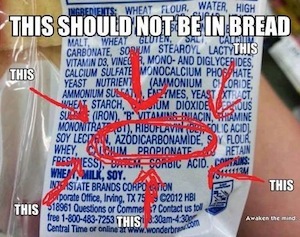Organic.org |
| Natural Remedy For Sore Throat Posted: 26 Feb 2014 02:13 PM PST Having a sore throat? Try this effective homemade remedy for sore throat instead of taking antibiotics and pills. Ingredients:
Cut up a couple of lemons and put them into the jar. Fill half of the jar. Then grate the ginger into the jar, and over this mixture slowly pour the honey to settle between all the lemon pieces. Keep the jar in the fridge and wait until the mixture turns into jelly. Use: Take a spoonful of the jelly and add it in hot water. You can drink this tea whenever you have a sore throat. This homemade remedy is good for 3 months and it is recommended for all ages. [via Health Care Above All] |
| Gluten Intolerant? You May Just Be Intolerant of Monsanto Weed Killer Posted: 26 Feb 2014 07:56 AM PST Scientists suggest that Monsanto's Roundup herbicide is what's making people have such a nasty reaction to glutenGluten has been a major news item for the last few years—not just for sufferers of acute gluten intolerance and celiac disease, but for increasing numbers of people who are seeking to eliminate gluten from their diet for general health issues, weight control, skin health and even mood. As cholesterol and the carbs once were, gluten is the new enemy, to the point that some have claimed it's a substance that the body isn't equipped to handle.I've even heard people blame gluten for all of the ails of modern civilization: After all, the cultivation of wheat, some say, is the birth of agriculture, and the ownership of crops goes hand in hand with the ownership of people that characterizes patriarchal, hierarchical civilization. Bread and beer, both products of wheat, people like Terence McKenna have suggested, are responsible for our generally degenerate state. But all over-the-top speculation aside, a new scientific review has suggested a far more specific problem with gluten: And it has nothing to do with wheat itself. Rather, the peer-reviewed article "Glyphosate, pathways to modern diseases Celiac sprue and gluten intolerance" suggests that the real criminal isn't gluten but, rather, Glyphosate, AKA Roundup, the Monsanto-manufactured weedkiller used around the world. Glyphosate is sprayed on crops genetically engineered to be "Roundup Ready," meaning that the crops resist the poison, while any nearby weeds are immediately killed. But that potentially leaves the end-product consumer with two toxic vectors to deal with: not only the Roundup that was sprayed on the crops, but, in some cases, the prior genetic engineering done to the crops themselves. The review abstract lists the following allegations: • 5% of the population in North America and Europe suffer from celiac disease and gluten intolerance, leading to nausea, diarrhea, rashes, macrocytic anemia (swollen red blood cells combined with lack of red blood cells overall) and depression. It can also lead to increased risk for thyroid disease, kidney failure, cancer, non-Hodgkin's lymphoma, infertility, birth defects and miscarriages. • Glyphosate is the key culprit for all of this. • Fish exposed to glyphosate get symptoms similar to celiac disease. • Glyphosate impairs the enzymes that detox environmental toxins, chelates key minerals (meaning you don't absorb them), depletes key amino acids • Glyphosate is often used to artificially "ripen" crops, which the study blames for kidney failures in Central American sugar cane workers. Bad news for Monsanto, especially after the recent kerfluffle over the prior, extremely controversial Seralini study on glyphosate. Because very little negative research has been done into Glyphosate (because, as activists allege, Monsanto funds nearly all the studies into Glyphosate), it's been slow going in building a case against Roundup. But this information—which looks much more sound than the Seralini study—may prove yet another arrow in Monsanto's side. [via Ultraculture] |
| You are subscribed to email updates from Organic.org To stop receiving these emails, you may unsubscribe now. | Email delivery powered by Google |
| Google Inc., 20 West Kinzie, Chicago IL USA 60610 | |




















